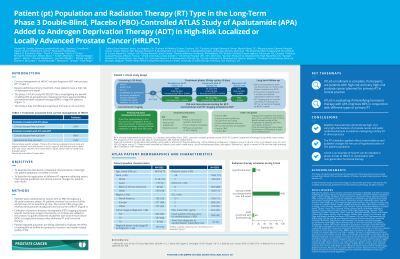Back

Industry Encore Posters
JL1023E: Patient (pt) population and radiation therapy (RT) type in the long-term phase 3 double-blind, placebo (PBO)-controlled ATLAS study of apalutamide (APA) added to androgen deprivation therapy (ADT) in high-risk localized or locally advanced prostate cancer (HRLPC)
Saturday, October 22, 2022
10:00 AM – 11:00 AM ET


Kelly Hastings, MSN, ANP-BC
Medical Science Liaison
Janssen Research & Development
Poster Presenter(s)
Background:
Current management of HRLPC includes long-term ADT with primary RT. Despite definitive primary treatment, these pts have a high risk of metastasis and death. The phase 3 ATLAS study (NCT02531516) is investigating whether treatment intensification with the addition of APA to neoadjuvant and adjuvant treatment with gonadotropin-releasing hormone agonist (GnRHa) and external beam radiation therapy (EBRT) will improve metastasis-free survival (MFS) in high-risk pts. Here we describe (1) the distribution of baseline characteristics in this high-risk pt population and (2) the application of different RT regimens reflecting recent international guidelines and clinical practice changes for pts with HRLPC.
Methods:
Eligible HRLPC pts (Gleason score [GS] ≥ 8 or 7 and prostate-specific antigen [PSA] ≥ 20 ng/mL and stage ≥ cT2c), with ECOG PS 0/1 and Charlson Comorbidity Index (CCI) ≤ 3 are stratified by GS, pelvic nodal status, use of brachytherapy boost, and region; pts are randomized 1:1 to APA or PBO plus GnRHa for 30 (28-d) treatment cycles. Study treatment is applied neoadjuvant/concurrent to RT with APA 240 mg/d vs bicalutamide 50 mg/d for 4 cycles; another 26 cycles are completed adjuvantly after RT with APA 240 mg/d vs PBO. Primary end point is MFS (time from randomization to first distant metastasis on CT/MRI/bone scan by independent central review blinded to treatment or death from any cause). Imaging is conducted at baseline and q6m from biochemical failure until MFS. The protocol has been amended to include PET imaging (PSMA, fluciclovine, or choline).
Results:
Pts (N = 1503) were randomized at 266 sites in 24 countries in North America, Latin America, Europe, and Asia. The study is fully enrolled, but ongoing. Baseline characteristics for the total population: median age, 67 yrs; ECOG PS 0/1, 89%/11%; tumor classification at study entry: high-risk, 66%/very high–risk, 34%; median PSA, 6.3 ng/mL; cT2, 44%/cT3, 50%; cN1, 13%. In 90% of ATLAS pts, RT used was standard EBRT to prostate/pelvis over 6-8 weeks (cumulative 78-81 Gy); in 10%, recent hypofractionation schedules (per CHHiP or NRG/RTOG 0415) were applied (20´3 Gy/d or 28´2.5 Gy/d). 5.6% of pts had EBRT combined with brachytherapy (per ASCENDE-RT).
Conclusions:
Baseline characteristics of the ATLAS study population are reflective of pts with high- and very high–risk features and pelvic nodal involvement undergoing primary RT in clinical practice. The RT schedules applied reflect recent evidence and guideline changes for the use of hypofractionation in this pt population. ATLAS is an example of how RT can be included in phase 3 trials of HRLPC, in combination with next-generation androgen receptor inhibitors (eg, APA).
© 2022 American Society of Clinical Oncology, Inc. Reused with permission. This abstract was accepted and previously presented at the 2022 ASCO Annual Meeting. All rights reserved.
Current management of HRLPC includes long-term ADT with primary RT. Despite definitive primary treatment, these pts have a high risk of metastasis and death. The phase 3 ATLAS study (NCT02531516) is investigating whether treatment intensification with the addition of APA to neoadjuvant and adjuvant treatment with gonadotropin-releasing hormone agonist (GnRHa) and external beam radiation therapy (EBRT) will improve metastasis-free survival (MFS) in high-risk pts. Here we describe (1) the distribution of baseline characteristics in this high-risk pt population and (2) the application of different RT regimens reflecting recent international guidelines and clinical practice changes for pts with HRLPC.
Methods:
Eligible HRLPC pts (Gleason score [GS] ≥ 8 or 7 and prostate-specific antigen [PSA] ≥ 20 ng/mL and stage ≥ cT2c), with ECOG PS 0/1 and Charlson Comorbidity Index (CCI) ≤ 3 are stratified by GS, pelvic nodal status, use of brachytherapy boost, and region; pts are randomized 1:1 to APA or PBO plus GnRHa for 30 (28-d) treatment cycles. Study treatment is applied neoadjuvant/concurrent to RT with APA 240 mg/d vs bicalutamide 50 mg/d for 4 cycles; another 26 cycles are completed adjuvantly after RT with APA 240 mg/d vs PBO. Primary end point is MFS (time from randomization to first distant metastasis on CT/MRI/bone scan by independent central review blinded to treatment or death from any cause). Imaging is conducted at baseline and q6m from biochemical failure until MFS. The protocol has been amended to include PET imaging (PSMA, fluciclovine, or choline).
Results:
Pts (N = 1503) were randomized at 266 sites in 24 countries in North America, Latin America, Europe, and Asia. The study is fully enrolled, but ongoing. Baseline characteristics for the total population: median age, 67 yrs; ECOG PS 0/1, 89%/11%; tumor classification at study entry: high-risk, 66%/very high–risk, 34%; median PSA, 6.3 ng/mL; cT2, 44%/cT3, 50%; cN1, 13%. In 90% of ATLAS pts, RT used was standard EBRT to prostate/pelvis over 6-8 weeks (cumulative 78-81 Gy); in 10%, recent hypofractionation schedules (per CHHiP or NRG/RTOG 0415) were applied (20´3 Gy/d or 28´2.5 Gy/d). 5.6% of pts had EBRT combined with brachytherapy (per ASCENDE-RT).
Conclusions:
Baseline characteristics of the ATLAS study population are reflective of pts with high- and very high–risk features and pelvic nodal involvement undergoing primary RT in clinical practice. The RT schedules applied reflect recent evidence and guideline changes for the use of hypofractionation in this pt population. ATLAS is an example of how RT can be included in phase 3 trials of HRLPC, in combination with next-generation androgen receptor inhibitors (eg, APA).
© 2022 American Society of Clinical Oncology, Inc. Reused with permission. This abstract was accepted and previously presented at the 2022 ASCO Annual Meeting. All rights reserved.

